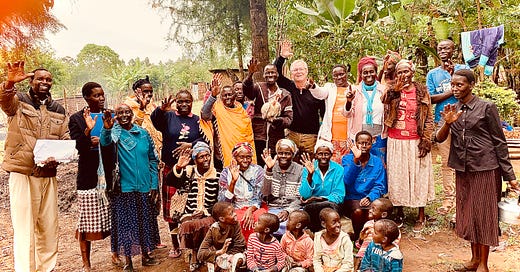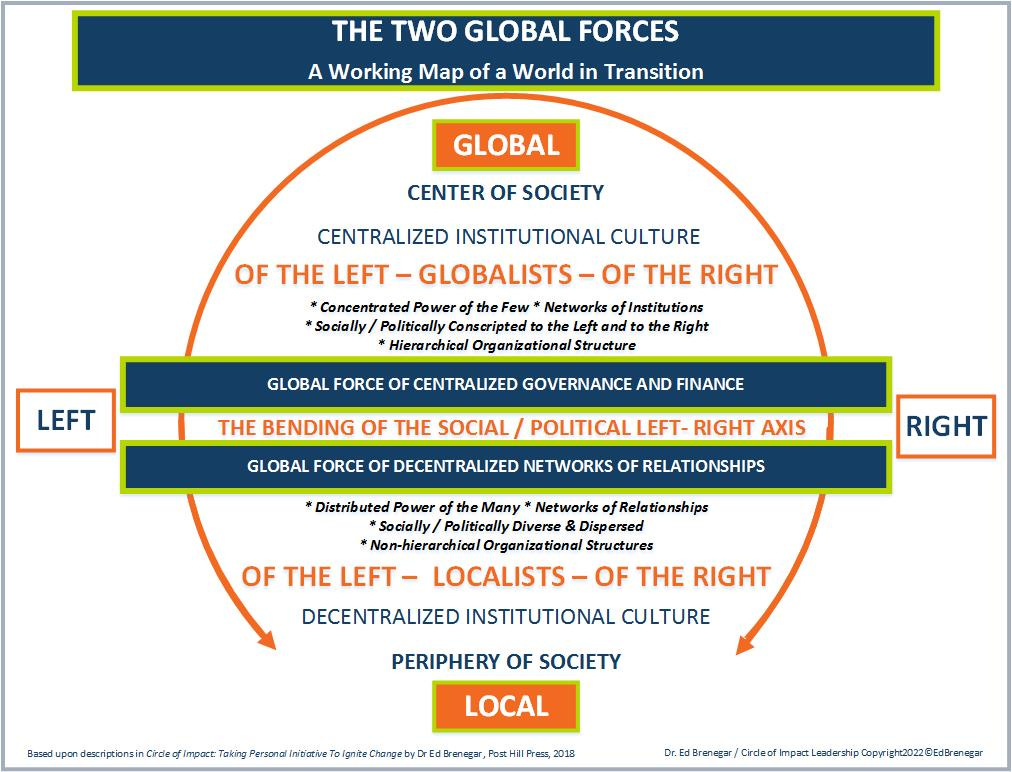The Globalization of My Life
A decade ago my life was small and self-contained. Today it is global and expanding in reach.
What happened?
First I went through three losses. My consulting practice died. I was fired from the leadership of the non-profit I directed. And, my marriage ended.
What did I do?
I started over. I moved across the country to a place I had always loved. I invested time and money in developing my skills of thought leadership through writing. I published my first book. And I began to conduct leadership training in Africa.
What did I learn?
Two things.
First, the socio-political media culture invites us to become absorbed in global issues.
It causes us to feel like we are global citizens. Simply commenting on global issues, like the war in Ukraine does not make you a global citizen. Unless you have a direct connection to people in the midst of that war, you are simply being used to promote one narrative or another. This is the simulated character of contemporary global engagement.
Second, all global issues are local issues.
Every war, pandemic, trucker convoy, empty grocery shelf, and container ship anchored offshore of a port is a local problem. They affect people in local communities. People die. The homes are bombed. They lose their jobs. Until you actually know those people, you are not a global citizen but a global observer. The consequence is that we can easily become disconnected from our own local community by focusing on the importance of simulated crises. They are simulations until they force your life to change.
Globalization’s future
We live in a globalized world. This world appears to us through the projection of the importance of global institutions. We view them as the center of global society. See my previous column on how societies are constituted through a center and a periphery. The global center is now separating itself from all local communities of the global periphery. It is why local organizations do not respond to the public but to national and global media.
This global center of institutions of finance and governance is one of the Two Global Forces that I write about. It is a world of institutions. It is a world detached from most of us. The other global force is that of networks of relationships that connect people on a global scale in the context of their local lives.
These global institutions have made a claim to the leadership of the world. They perceive themselves as taking responsibility for the progress of the world. Ironically all the global crises like the war in Ukraine, for the COVID-19 pandemic, for the supply chain crisis, for the growing food scarcity crisis, and for the political tribalism that afflicts social media platforms are products of this global culture that is detached from our local lives. It certainly affects us. But there is little we can do to stop the Russo-Ukraine war. Little we can do to avert famine because of government actions to control the flow of goods. On a global scale, we are powerless. On a local scale, we have tremendous resources available to us. All we must do is recognize that every local community has its own societal center and periphery.
The global center is shrinking. The more visible they become the clearer our understanding of their purpose. I am suggesting here that there are two different approaches to globalism that we should see. Each one of us, each of our businesses, and our local communities are peripheral to the global center. Their goals and actions are based on a set of values that are not typically representative of the goals and values present in local communities.
My Two Global Forces framework provides a way of understanding the differences in these two perspectives of globalization. Just like the distinction that I made in my previous column between the Center and the Periphery of society. The Two Global Forces illustrate the relation between concentrated and distributed power. This is the Centralization-Decentralization relation.
Centralization – Decentralization in Transition
The problem with most Centralized plans is that they seek to apply a one-size-fits-all approach to the management of crisis and development in organizations. I have seen this in my work. The result is the multiplication of residual problems. A residual problem is one that occurs because the solution presented to a problem in a local setting creates unintended consequences that make the situation worse. The more the failure of a uniform approach becomes apparent, the more the centralized authority doubles down on its initiative to demonstrate strength rather than weakness.
I was a loyal customer of a global business that had a local operation in my community. The context of this business created unique challenges and opportunities for the company. I was able to talk with the regional manager of the company who oversaw a couple dozen of their stores. It was clear that the home office wanted all their stores to operate in a uniform manner. But this store was in a unique setting where it had the opportunity to influence foreign travelers to become local customers back home. Unfortunately, that was just too sophisticated a strategy for this company. They now have closed the store because it just did not fit into their one-size-fits-all approach.
The conflict embedded in this company’s structure is the relationship between centralized planning and decentralized execution. The movement from centralization to decentralization is a cyclical one. By this, I mean that there is an equilibrium between the Center and the Periphery that requires constant maintenance. If the Center cannot hold the organization together, the Periphery will independently begin to try to resolve the problems that impact them. If the Periphery finds that its problems are created by the Center, then it will begin to push back, seeking new avenues for resolution.
As the global force of networks of institutions pushes for greater control over the world, they become increasingly irrelevant and problematic to the periphery. As a result, the global force of networks of relationships begins to concentrate on how to address the local problems that it faces.
During the first year of the COVID-19 pandemic, I had a number of conversations with people I knew in Africa who were having difficulty feeding their people. Their government’s policy of lockdowns was creating localized instances of starvation. These local leaders in their communities would weekly send me messages about another member of their community dying from starvation. This is a picture of how a global crisis is really a local one.
We are still addressing the local needs that they have. They are the same needs that can be found in every developing country that has been exploited by globally centralized institutions. This is simply a new form of the old colonialism that should have gone away, but it has not. It has just re-emerged in a new form.
A Simple Way to See Centralized and Decentralized Globalization
There is a growing emergence of decentralized network building taking place. Part of the reason is that the institutional center of global society has become increasingly detached from local communities. This is a cycle of growth and decline.
Centralization of global institutions – individuals – local focus = Globalization
Decentralization of global institutions + individuals + local focus = local networks of relationships + new local institutions
In other words, a balance is taking place where local problems can be addressed through global networks of relationships. This is the beginning of the future. What follows from this is still an open question. This a question that each of you who are reading this can become a participant in searching for a way to contribute to a better future.
The Reversal of Centralization
I witnessed this during the 1990s and 2000s when I worked on local development projects. I discovered that there was a predatory relationship between the layers of government – federal, state, county, and local municipality. There was a type of dependency formed that higher levels of government used against the lower ones. Sometimes the conflict would end in the courts. Often the result was a return of equilibrium to the relationship that the lower governments had with the higher. This is the essential conflict that exists where centralization becomes the default strategy.
The increasing centralization of the administrative component of organizations shifts the focus from service to the customer to the growing need for resources to sustain a growing and more complex structure. I see this pattern of behavior as pushing the organization to its extremity.
On a global scale, it is the rationale offered a century ago that nations could no longer be trusted to serve the interests of world peace and prosperity. As a result, global institutions that have no governance accountability grew to dominate. We are now witnessing the effect of pushing global centralization to its extremity. It is reversing the cycle to produce an increasing decentralizing effect.
The problem is that when an institution begins to turn inward, seeking its own welfare, it has begun a process of reversal. Social theorist Jean Baudrillard describes this reversal as the ability of people and organizations to undermine their own functioning. I see this in businesses that have grown to the point that they are unable to provide any sort of customer service component. They exist to sell.
As Joseph Tainter states, a societal collapse is “a rapid simplification of a complex system.” This collapse is the ultimate reversal. The transition from centralized systems to decentralized systems is also a reversal. Each case, in turn, opens up opportunities that were formerly unavailable.
As a result, the transition that I see taking place is one that will grow in importance over the next several years. Nothing is inevitable, yet the order of nature does have a hand in how the world functions. Push a machine to its extremity it will fail. Push a society to its extremity of fear and control, it will fail.
As a result, we have a choice to make.
The choice is between global unification through the network of global institutions or the choice of global unification through local networks of individuals and communities.
With the former, it is a choice of growing disempowerment as a person and community. With the latter, it is a choice to take responsibility for your local community so that the social fabric holds together.





